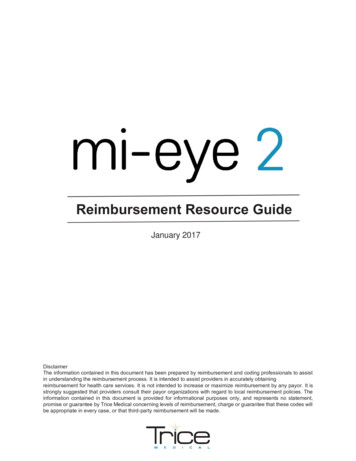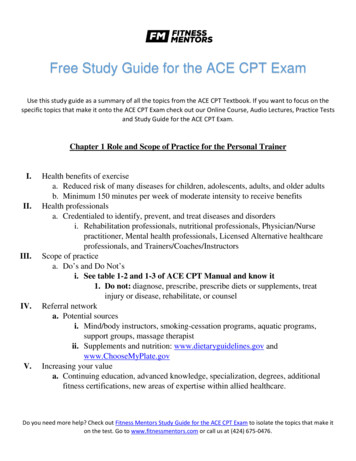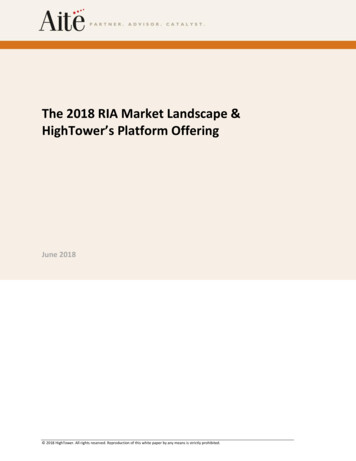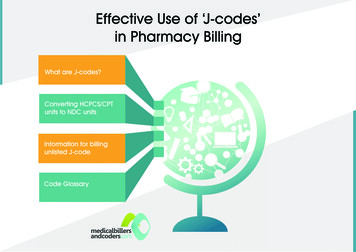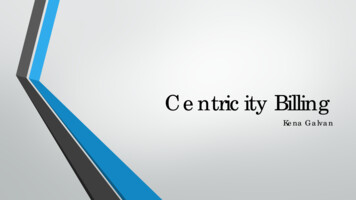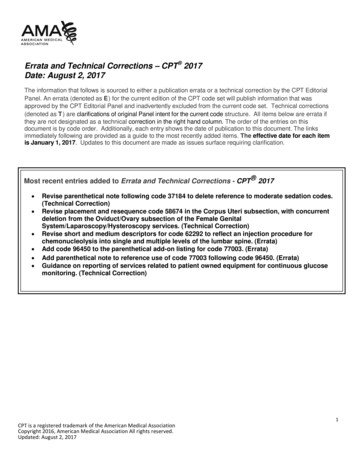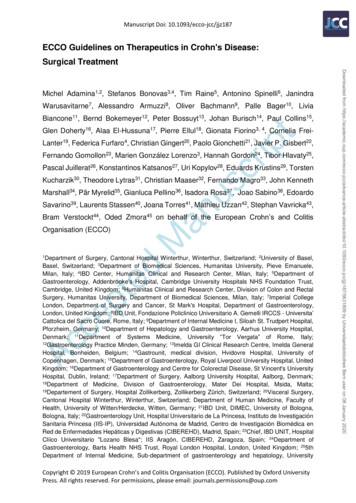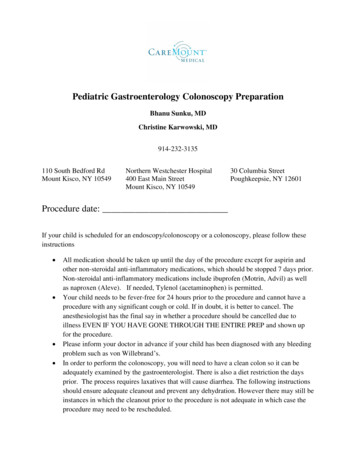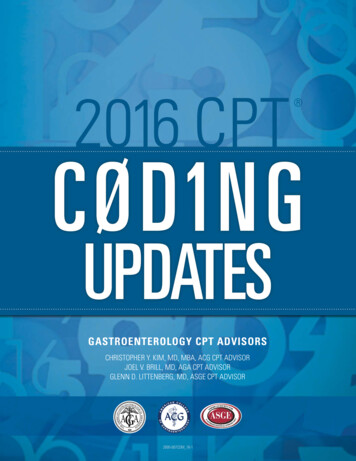
Transcription
GASTROENTEROLOGY CPT ADVISORSCHRISTOPHER Y. KIM, MD, MBA, ACG CPT ADVISORJOEL V. BRILL, MD, AGA CPT ADVISORGLENN D. LITTENBERG, MD, ASGE CPT ADVISOR2695-007COM 16-1
2016 CPT Coding UpdateThe American College of Gastroenterology (ACG), American Gastroenterological Association (AGA) and AmericanSociety for Gastrointestinal Endoscopy (ASGE) work closely together to ensure that adequate methods are in placefor gastroenterology practices to report and obtain fair and reasonable reimbursement for procedures, tests andvisits. The societies’ advisors continuously review Current Procedural Terminology (CPT ) and work through the AMAprocess to revise and add new codes, as appropriate.22016 CPT CODING UPDATES
Table of ContentsCoding Updates4Other Changes and Clarifications4Colonoscopy6Frequently Asked Questions832016 CPT CODING UPDATES
Beginning January 1, 2016, the Centers for Medicare and Medicaid Services (CMS) will acceptclaims using the 2016 Category I CPT codes for lower GI endoscopy procedures.Coding UpdatesCategory I CodeESOPHAGOGASTRIC FUNDOPLASTYCode 43210 — A new code has been established in the Esophagogastroduodenoscopy section to describe a transoral approach to a surgical esophagogastric fundoplasty procedure. Code 43210, Esophagogastroduodenoscopy,flexible, transoral; with esophagogastric fundoplasty, partial or complete, includes duodenoscopy when performed, isfor a partial or complete esophagogastric fundoplasty and includes duodenoscopy when performed.An exclusionary parenthetical note has been added to restrict the use of this code with esophagoscopy and EGDservices 43180, 43191, 43197, 43200 and 43235.Other Changes and ClarificationsCategory I CodesLIVER ELASTOGRAPHYCode 91200, Liver elastography, mechanically induced shear wave (e.g., vibration), without imaging, withinterpretation and report, was added in 2015 to report liver elastography performed via mechanically-induced shearwave technique, such as vibration. The code, which describes liver fibrosis evaluation, includes interpretation andreport, but not imaging. CMS has clarified that should an evaluation and management service be performed on thesame day, it is separately reportable.ESOPHAGEAL BALLOON DISTENSION STUDYCode 91040, Esophageal balloon distension study, diagnostic, with provocation when performed, was revised for2016 to clarify this as a diagnostic procedure. Code 91040 does not require the performance of provocation to reportthis procedure. While esophageal distension is measured in all patients who undergo esophageal balloon distension,not all patients undergo provocation during the performance of the study.CARE MANAGEMENT SERVICESIn 2015, CPT renamed the Complex Chronic Care Coordination Services section Care Management Services. Theguidelines section was completely revised and added two new subsections, Chronic Care Management Services andComplex Chronic Care Management Services.42016 CPT CODING UPDATES
The Chronic Care Management Services subsection includes guidelines for code 99490 clarifying that this code isreported for patients receiving at least 20 minutes of chronic care management per calendar month. Service of lessthan 20 minutes per calendar month is not reported separately. The Complex Chronic Care Management Servicessubsection includes guidelines for revised codes 99487 and 99489 that describe at least 60 minutes of complexchronic care management services. It includes information on identification of patients receiving complex care andexamples of typical patients. Service of less than 60 minutes per calendar month is not reported separately. Addon code 99489 cannot be reported for less than 30 minutes of service in addition to the initial 60 minutes during acalendar month reported with code 99497.ADVANCE CARE PLANNINGCodes 99497 and 99498 are used to report the face-to-face service between a physician or other qualified healthcare professional and a patient, family member or surrogate in counseling and discussing advance directives, with orwithout completing relevant legal forms. Code 99497 is used to report the first 30 minutes of advance care planning.Add-on code 99498 is used to report each additional 30 minutes.Category III CodesCategory III codes are a temporary set of codes for emerging technologies, services and procedures. These codes“sunset,” or are retired, from the CPT book after five years, if they are not accepted as Category I codes. Theytypically replace unlisted codes that were previously used for new procedures or services. If a Category III codedescribes the procedure or service performed, it must be reported. An unlisted code or less specific Category I codecannot be reported in place of an active Category III code. Category III codes are released on a semi-annual basis inJanuary and July and are published on the AMA’s website.New Category III CodesCodes 0392T, Laparoscopy, surgical, esophageal sphincter augmentation procedure, placement of sphincteraugmentation device (i.e., magnetic band), and 0393T, Removal of esophageal sphincter augmentation device, havebeen established to report insertion and removal of a magnetic band placed externally on the esophageal sphincter.These codes should be used for reporting the surgical placement and removal of esophageal sphincter augmentationdevices for the treatment of conditions such as gastroesophageal reflux disease (GERD). There is an exclusionaryparenthetical note to not report 0393T with other laparoscopic fundoplasty procedures as described in codes 43279,43280, 43281 and 43282.Code 0397T, Endoscopic retrograde cholangiopancreatography (ERCP), with optical endomicroscopy (List separatelyin addition to code for primary procedure), is an add-on code to report optical endomicroscopy (OE) services whenperformed with an ERCP procedure to assist in the diagnosis of biliary strictures and the presence of biliary cancer.Report code 0397T in addition to the code for the ERCP procedure; do not report 0397T in conjunction with code88375.Code 0405T, Oversight of the care of an extracorporeal liver assist system patient requiring review of status, reviewof laboratories and other studies, and revision of orders and liver assist care plan (as appropriate), within a calendarmonth, 30 minutes or more of non-face-to-face time, has been established to report oversight of the care of anextracorporeal liver assist system patient, and is used to track enrollment of patients into a liver assist system clinicaltrial to capture physician work related to oversight of the patient’s care. Services reported with 0405T are separatefrom critical care and other evaluation and management services.52016 CPT CODING UPDATES
Deleted Category III CodesEffective January 1, 2016, codes 0240T, Esophageal motility (manometric study of the esophagus and/orgastroesophageal junction) study with interpretation and report; with high resolution esophageal pressuretopography, and 0241T, Esophageal motility (manometric study of the esophagus and/or gastroesophageal junction)study with interpretation and report; with stimulation or perfusion during high resolution esophageal pressuretopography study (e.g., stimulant, acid or alkali perfusion) (List separately in addition to code for primary procedure),have been deleted. To report esophageal manometry with high resolution esophageal pressure topography, use codes91299. To report esophageal manometry, report 91010, 91013, as appropriate.Endoscopic Mucosal ResectionEndoscopic mucosal resection (EMR) includes cap-assisted or ligation-assisted (banding) removal of a lesion,along with injection-assisted snare removal techniques. Whether performed in the upper or lower GI tract, EMRrequires the lift technique to create a space beneath the lesion to isolate the lesion from underlying submucosa,which allows for a more complete removal that is safer in terms of bleeding and perforation risk, and the use of aspecialized device to isolate the tissue to be removed. Coding for EMR procedures requires the performance of 1)submucosal injection to lift the lesion; 2) demarcation of the lesion, often by creating a pseudopolyp out of tissue;AND 3) endoscopic snare resection. If all three components are not performed, it is not appropriate to report an EMRprocedure; rather, service(s) performed (submucosal injection, snare polypectomy) are reported, with modifier 59 onthe secondary procedure(s). When biopsy is performed on the same lesion as EMR, biopsy is not reported. Likewise,ablations of the edges of the lesion, clipping of the defect or other bleeding treatment to the same lesion are notseparately reported.ColonoscopyThe definition of a colonoscopy examination was revised in calendar year 2015. Colonoscopy is now defined as theexamination of the entire colon, from the rectum to the cecum or colon-small intestine anastomosis, and may includeexamination of the terminal ileum or small intestine proximal to an anastomosis.XX Whenperforming a diagnostic or screening endoscopic procedure on a patient who is scheduled and preparedfor a total colonoscopy, if the physician is unable to advance the colonoscope to the cecum or colon-smallintestine anastomosis due to unforeseen circumstances, report 45378 (colonoscopy) or 44388 (colonoscopythrough stoma) with modifier 53 and provide appropriate documentation.XX Ifa therapeutic colonoscopy (44389-44407, 45379, 45380, 45381, 45382, 45384, 45388, 45398) is performed anddoes not reach the cecum or colon-small intestine anastomosis, report the appropriate therapeutic colonoscopycode with modifier 52 and provide appropriate documentation.XX Reportileoscopy through stoma (44380, 44381, 44382, 44384) for endoscopic examination of a patient who hasan ileostomy.XXForcolonoscopy per rectum, see 45378-45398.62016 CPT CODING UPDATES
Reporting Examination of the Distal Defunctionalized ColonCPT provides guidance on how to code for both endoscopic examination of the colon that remains above a stoma(colostomy) and, at the same time, examination of the bypassed or defunctionalized colon. If a patient has acolostomy, an exam from stoma to cecum would entail a colonoscopy through stoma (44388 series), and examinationof the retained portions of the colon are coded with an anoscopy, proctosigmoidoscopy or flexible sigmoidoscopycode, as appropriate.Colonoscopy Decision TreePage 295 of the 2016 CPT Professional Guide contains the corrected Colonoscopy Decision Tree. When coding atherapeutic procedure to the cecum, bill the appropriate colonoscopy CPT code with no modifier. Please note that the“Diagnostic Procedure” decision node can include screening or diagnostic procedures.FlexibleSigmoidoscopy(45331 – 45347)72016 CPT CODING UPDATES Colonoscopy(45379 – 45398,52 Modifier)Colonoscopy(45379 – 45398,No Modifier)
FREQUENTLY ASKED CODING QUESTIONSJOEL V. BRILL, MD; CHRISTOPHER Y. KIM, MD, MBA; GLENN D. LITTENBERG, MD;KATHLEEN A. MUELLER, RN, CPC, CCS-P, CMSCS, CCC, PCS; DENISE GARRIS, CPC; LESLIE NARRAMORE, MPAQUESTION: When a bleeding ulcer is cauterized in the body of the stomach and a biopsy is taken from a separatearea, code 43255 Esophagogastroduodenoscopy (EGD) with control of bleeding, is denied when billed with 43239-59,EGD with biopsy. How should we bill this?ANSWER: Control of bleeding caused by an endoscopic procedure is bundled into every procedure. However, forcontrol of bleeding for a separate site/lesion, use modifier 59 with 43255 (control of bleeding) in addition to theprimary procedure.QUESTION: How should we report an attempted endoscopic retrograde cholangiopancreatography (ERCP) when thecommon bile duct is not able to be cannulated or injected?ANSWER: CPT instructs that the physician report this as an EGD procedure.QUESTION: How do you report endoscopic ultrasound (EUS) with optical endomicroscopy (OE) and fine needleaspiration (FNA) of a pancreatic cyst?ANSWER: The EUS/FNA procedure is reported using code 43238, Esophagogastroduodenoscopy, flexible, transoral;with transendoscopic ultrasound-guided intramural or transmural fine needle aspiration/biopsy(s), (includesendoscopic ultrasound examination limited to the esophagus, stomach or duodenum, and adjacent structures), orcode 43242, Esophagogastroduodenoscopy, flexible, transoral; with transendoscopic ultrasound-guided intramural ortransmural fine needle aspiration/biopsy(s) (includes endoscopic ultrasound examination of the esophagus, stomach,and either the duodenum or a surgically altered stomach where the jejunum is examined distal to the anastomosis),depending on whether the EUS is limited (43238) or includes the esophagus, stomach, AND duodenum (43242). TheOE is reported using code 43252, Esophagogastroduodenoscopy, flexible, transoral; with optical endomicroscopy.QUESTION: What is a diagnostic colonoscopy?ANSWER: A diagnostic colonoscopy is a procedure performed for the evaluation of a patient who presents withsymptoms and/or abnormalities prompting evaluation of the lower GI tract.Standard insurance benefits apply. Payors may use external criteria for determining coverage/medical necessityof the procedure, such as MCG (formerly known as Milliman Care Guidelines), InterQual and/or the 2012 ASGEAppropriate Use of Gastrointestinal Endoscopy Guidelines.QUESTION: What are the indications for coverage of a preventive service?ANSWER: For plan years beginning on or after January 1, 2014, the Affordable Care Act of 2010 (ACA) requires fullyinsured non-grandfathered individual and small group plans (inside and outside of exchanges) to provide coveragefor 10 categories of essential health benefits (EHBs). Large group plans (both self-funded and fully insured) andsmall group Administrative Services Only (ASO) plans, are not subject to the requirement to offer coverage for EHBs.However, if such plans choose to provide coverage for benefits that are deemed EHBs (such as maternity benefits),the ACA requires all dollar limits on those benefits to be removed on all grandfathered and non-grandfathered plans.The determination of which benefits constitute EHBs is made on a state-by-state basis.Effective for plan years on or after September 23, 2010, the federal Patient Protection and Affordable Care Act(PPACA) requires non-grandfathered health plans to cover certain “recommended preventive services” as identified/82016 CPT CODING UPDATES
mandated by PPACA. These services are described in the United States Preventive Services Task Force A and Brecommendations, the Advisory Committee on Immunization Practices of the CDC, and Health Resources and ServicesAdministration Guidelines, including the American Academy of Pediatrics Bright Futures periodicity guidelines.QUESTION: Can plans impose cost-sharing for preventive services if the patient is seen by a non-network provider?ANSWER: YesQUESTION: What are preventive colorectal cancer (CRC) screening services?ANSWER: Preventive colorectal cancer screening services include CRC screening tests, such as fecal occult bloodtest (FOBT), fecal immunochemical test (FIT), flexible sigmoidoscopy, colonoscopy, CT colonography, or CologuardTM .If a patient undergoes a CRC screening test by another health-care professional and an abnormality (e.g. positive test)is found that prompts referral for a colonoscopy, for Medicare, the colonoscopy is no longer a screening procedureand is no longer a preventive service.For Medicare, this means that the patient is now responsible for the co-pay and deductible for the diagnosticcolonoscopy, as it is not appropriate to code Z12.11 or Z12.12 for the colonoscopy. Note that CT colonography is not acovered service for CRC screening for Medicare. Cologuard is a covered service for Medicare beneficiaries.For commercial payors, check the medical policy to see whether CT colonography and/or Cologuard are coveredservices for CRC screening. Check the summary plan description (SPD) and/or payor policy to see if a colonoscopyperformed in an asymptomatic patient with a positive FOBT, FIT, Cologuard, flexible sigmoidoscopy or CTcolonography is or is not still a preventive service (with waiver of financial responsibility).QUESTION: Can you explain the difference between average-risk and high-risk screening when submitting claimsfor screening colonoscopy?ANSWER: Listed below are Medicare’s definitions of average and high risk. Commercial payors may decide tofollow Medicare policy on colorectal cancer (CRC) screening or use their own definitions. Check with the payor ontheir coding and coverage policies and benefits.Screening: Lack of symptoms and abnormalitiesAccording to Medicare, screening is, by definition, a service performed on a patient in the absence of signs andsymptoms. Once the patient is diagnosed with polyps, even hyperplastic polyps, follow-up endoscopy is surveillance.Use the ICD-10 codes to identify surveillance.Average and High Risk:Medicare considers an individual at high risk for developing colorectal cancer as one who has one or more of thefollowing:XX Aclose relative (sibling, parent or child) who has had colorectal cancer or an adenomatous polyp.XX Afamily history of familial adenomatous polyposis.XX Afamily history of hereditary nonpolyposis colorectal cancer.XX Apersonal history of adenomatous polyps.XX Apersonal history of colorectal cancer.XX Inflammatorybowel disease, including Crohn’s disease and ulcerative colitis.92016 CPT CODING UPDATES
Average risk is a patient who does not meet the above criteria for high risk.Medicare defines a close relative as first degree siblings, parents or children. Commercial payors may define familyhistory to also include second degree relatives. If there are questions, check the patient’s SPD and/or the plan’scoverage policies.Hyperplastic polyps do not meet the definition of high risk as these are not adenomatous polyps. Patientswho only have hyperplastic polyps are considered to be average risk if there are no other high-risk factors, asdescribed above.QUESTION: Some U.S. Preventive Services Task Force (USPSTF) recommendations apply to certain populationsidentified as high-risk. Some individuals, for example, are at increased risk for certain diseases, because they have afamily or personal history of the disease. How can a plan or issuer determine when a service should or should not becovered without cost-sharing?ANSWER: Identification of “high-risk” individuals is determined by clinical expertise. Decisions regarding whetheran individual is part of a high-risk population, and should therefore receive a specific preventive item or serviceidentified for those at high-risk, should be made by the attending provider. Therefore, if the attending providerdetermines that a patient belongs to a high-risk population and a USPSTF recommendation applies to that high-riskpopulation, that service is required to be covered in accordance with the requirements of the interim final regulations(that is, without cost-sharing, subject to reasonable medical management).QUESTION: Are there criteria for defining patients at increased/high-risk for colorectal cancer screening?ANSWER: The National Comprehensive Cancer Network (NCCN) Guidelines for detection, prevention and riskreduction provide the following definitions:Positive family history of CRC:XX Individualswith a first-degree relative (i.e., full sibling, parent, child) age 60 years with CRC, or two firstdegree relatives with CRC at any age: Colonoscopy should begin at age 40 or 10 years before earliest diagnosis of CRC and repeat colonoscopyevery three to five years depending on individual family history.XX Individualswith a first-degree relative with CRC 60 years: Colonoscopy should begin at age 50 or 10 years before earliest diagnosis of CRC and repeat colonoscopyevery five years.XX Individualwith one second degree relative with CRC 50 years: Colonoscopy should begin at age 50 and repeat colonoscopy per colonoscopy findings.XX First-degreerelatives with advanced adenoma: Colonoscopy should begin at age 50 or age of onset, whichever is first, then repeat colonoscopy percolonoscopy findings.Personal or inherited risk of polyposis syndromes:XX Familyhistory of familial adenomatous polyposis (FAP): Individual is a genetic carrier:n Annual flexible sigmoidoscopy or colonoscopy, beginning at age 10 to 15.102016 CPT CODING UPDATES
Genetic status is unknown:n Annual flexible sigmoidoscopy or colonoscopy, beginning at age 10 to 15, until age 24 then:n Repeat every two years until age 34.n Repeat every three years until age 44.n Then every three to five years thereafter. Individual is not a carrier:nXX Family Average-risk screening should occur.history of attenuated FAP (AFAP) Individual is a genetic carrier:n Annual colonoscopy beginning in late teens, then every two to three years. Genetic status is unknown:nC olonoscopy every two to three years beginning in late teens; if adenomas are found, annualcolonoscopy. Individual is not a carrier:n Average-risk screening should occur.XX MYH-associatedpolyposis (MAP): Unaffected family member and family mutation known; with biallelic MUTYH mutation positive or nottested:n Begin colonoscopy at age 25 to 30, and then every two to three years if negative.n Consider upper endoscopy and side viewing duodenoscopy starting at age 30 to 35 years. For personal history of MAP with small adenoma burden:nXX Lynch Colonoscopy and polypectomy every one to two years.syndrome: MLH1 and MSH2 mutation carriers (Lynch syndrome):nC olonoscopy age 20 to 25, or two to five years prior to the earliest colon cancer, if it is diagnosedbefore age 25 years, and repeat one to two years. MSH6 and PMS2 mutation carriers (Lynch syndrome):nC olonoscopy age 30 to 35 years and every two to three years, and then after age 40, every one to twoyears.QUESTION: What are the CPT and ICD-10 codes for screening and surveillance colonoscopy?ANSWER: Check with the payor as to which codes to bill the colonoscopy and the acceptable ICD-10 codes.Payors other than Medicare may allow additional ICD-10 codes for meeting criteria for screening and surveillance112016 CPT CODING UPDATES
colonoscopy.XX Billingfor a screening colonoscopy in an average-risk patient: G0121 (Medicare) or 45378 (Medicaid, commercial, exchange, Tricare) with the appropriate ICD-10 code forscreening:XX Billingn Z12.11 — encounter for screening for malignant neoplasm of colon.n Z12.12 — encounter for screening for malignant neoplasm of rectum.for screening colonoscopy in a high-risk patient: G0105 (Medicare) or 45378 (Medicaid, commercial, exchange, Tricare) with the appropriate ICD-10 code forscreening:n K50 — Crohn’s disease.n K51 — ulcerative colitis.n K52.1 — toxic gastroenteritis and colitis.n K52.89 — other specified noninfective gastroenteritis and colitis.n K52.9 — noninfective gastroenteritis and colitis, unspecified.n Z85.038 — personal history of other malignant lesion of large intestine.n Z85.048 — personal history of other malignant lesion of rectum, rectosigmoid junction and anus.n D12.6 — benign neoplasm of colon, unspecified.n Z15.09 — genetic susceptibility of other malignant neoplasm.n Z80.0 — family history of malignant neoplasm of digestive organs.n Z83.71 — family history of colonic polyps.n Z86.010 — personal history of benign neoplasm of colon.QUESTION: Is anesthesia covered for screening colonoscopy?ANSWER: Yes. Medicare and the departments (Labor, Treasury, Health and Human Services) have expanded thewaiver of co-pay and deductible to include anesthesia for screening colonoscopy. Modifier 33 should be added to the00810 anesthesia code to indicate the circumstance was preventive. In the circumstance when a screening procedurebecomes therapeutic, the PT modifier should be applied to the anesthesia service. A co-pay will still apply, but thedeductible should be waived.QUESTION: Is a pre-procedure evaluation and management (E/M) visit covered prior to a screening colonoscopy?ANSWER: Effective December 23, 2015, for patients other than Medicare, if a colonoscopy is scheduled andperformed as a screening procedure pursuant to the USPSTF’s recommendations, it is not permissible for a plan orissuer to impose cost sharing for the required specialist consultation prior to the screening procedure. According tothe departments, the plan or issuer may not impose cost sharing with respect to a required consultation prior to thescreening procedure if the attending provider determines that the pre-procedure consultation would be medicallyappropriate for the individual, because the pre-procedure consultation is an integral part of the colonoscopy. As withany invasive procedure, the consultation before the colonoscopy can be essential in order for the consumer to obtain122016 CPT CODING UPDATES
the full benefit of the colonoscopy safely.QUESTION: Is pathology covered when a lesion is found during a screening colonoscopy?ANSWER: During a screening colonoscopy, polyps or other lesions can be found, which are biopsied or removed.Effective December 23, 2015, for patients other than Medicare, the departments have clarified that such servicesperformed in conjunction with a preventive colonoscopy must be covered without cost sharing.XX Forcommercial payors, add modifier 33 to the surgical claim; use of this modifier informs the payor that theintent of the colonoscopy was a preventive service. If billed with screening as the principal diagnosis and thefinding as the secondary diagnosis, many commercial payors will continue to pay preventive benefits.Section 1834(d)(3)(D) of the Social Security Act states that, “[i]f during the course of such a screening colonoscopy,a lesion or growth is detected which results in a biopsy or removal of the lesion or growth, payment under this partshall not be made for the screening colonoscopy but shall be made for the procedure classified as a colonoscopy withsuch biopsy or removal.”XX Asa result, when an anticipated screening colonoscopy ends up involving a biopsy or polyp removal, Medicarecannot pay for this procedure as a screening colonoscopy.XX ForMedicare, add modifier PT to the surgical claim, which informs Medicare that the intent of the colonoscopywas a preventive service. Modifier PT waives the patient’s deductible, but the beneficiary is now responsible forthe 20 percent co-pay.XX Similarly,the beneficiary is responsible for paying the Part B coinsurance for the covered anesthesia.132016 CPT CODING UPDATES
QUESTION: What are the recommendations for surveillance intervals?ANSWER: If the screening colonoscopy on an average-risk patient is negative, Medicare allows a follow-upcolonoscopy every 10 years through age 75. The frequency for follow-up for commercial payors is dependent uponthe plan’s summary plan document (SPD), but most follow either CMS policy or the U.S. Multi-Specialty Task Force(MSTF) recommendations.Source: Guidelines for Colonoscopy Surveillance After Screening and Polypectomy: A Consensus Update by the US MultiSociety Task Force on Colorectal Cancer Gastroenterology 2012;143:844–857; doi:10.1053/j.gastro.2012.06.001; publishedonline 03 July 2012Medicare beneficiaries at high risk for developing colorectal cancer are eligible for follow-up colonoscopy once every24 months.QUESTION: What is the definition of screening vs. surveillance for commercial payors?ANSWER: Payors may have policies that indicate that once the patient has a condition that requires surveillance atintervals of less than 10 years, the patient is no longer eligible for preventive benefits.XX Eligibilityneeds to be verified on all patients prior to scheduling.XX Aftereligibility is verified, a thorough explanation of the patient’s benefits and financial responsibility should begiven to the patient in order for the patient to make an informed decision.QUESTION: What is the difference regarding the use of modifiers 52 and 53 with regards to upper and lowerendoscopic procedures?ANSWER: EGD procedures: To report esophagogastroscopy where the duodenum is deliberately not examined (e.g.,judged clinically not pertinent) or because significant situations preclude such exam (e.g., significant gastric retentionprecludes safe exam of duodenum), append modifier 52, if repeat examination is not planned, or modifier 53, if repeat142016 CPT CODING UPDATES
examination is planned.XX Example1: EGD is performed and a tube is placed into the stomach. The duodenum is not examined and thereis no plan to perform repeat EGD to examine the duodenum. Report procedure with modifier 52.XX Example2: EGD is performed for evaluation of GI bleeding; the stomach is full of blood and the duodenum isnot examined. Plan to control bleeding, lavage stomach and repeat upper endoscopy. Report procedure withmodifier 53.Colonoscopy procedures:XX Whenperforming a diagnostic or screening endoscopic procedure on a patient who is scheduled and preparedfor a total colonoscopy, if the physician is unable to advance the colonoscope to the cecum or colon-smallintestine anastomosis due to unforeseen circumstances, report 45378 (colonoscopy) or 44388 (colonoscopythrough stoma) with modifier 53 and provide appropriate documentation.XX Ifa therapeutic colonoscopy (44389-44407, 45379, 45380, 45381, 45382, 45384, 45388, 45398) is performed anddoes not reach the cecum or colon-small intestine anastomosis, report the appropriate therapeutic colonoscopycode with modifier 52 and provide appropriate documentation.QUESTION: Could you provide some examples of how to use and report modifiers 52 and 53 with regards to lowerendoscopic procedures?ANSWER:Example 1: Colonoscopy done for evaluation of iron deficiency anemia. The scope was passed beyond the splenicflexure, but not to the cecum or colon-small intestine anastomosis, because of inadequate prep. The physicianindicates that the patient will be brought back for repeat procedure after re-prep tomorrow. Since the exam wasincomplete for unforeseen circumstances,
2016 CPT Coding Update. 3 . interpretation and report, was added in 2015 to report liver elastography performed via mechanically-induced shear wave technique, such as vibration. The code, which describes liver fibrosis evaluation, includes interpretation and . from the CPT book after fiv
